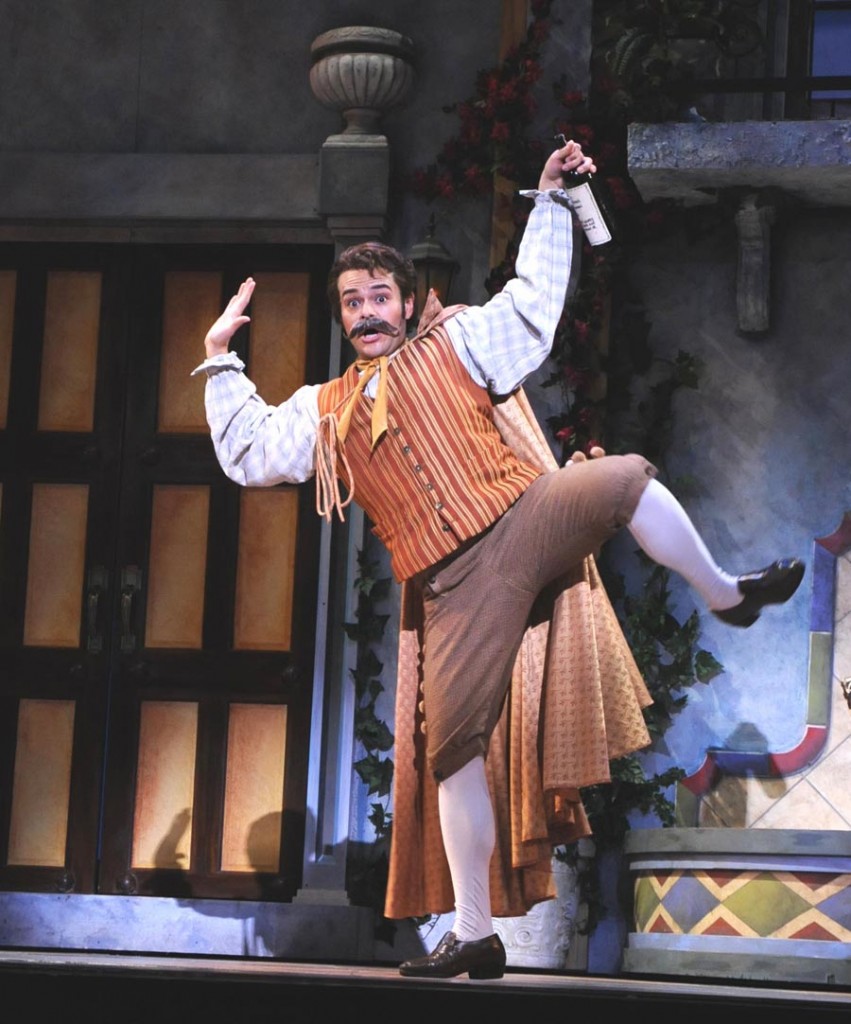How can anyone not like Rossini’s The Barber of Seville? The music is so light-hearted and tuneful, the good guys are so sweet and simple, the bad guys are so ridiculous you can’t hate them, the love story is so predictable, and the details of the plot are so absurd – what is there not to like?
The libretto by Cesare Sterbini, based on the play by Beaumarchais is filled with humor, the music itself is humorous, and the tradition (at least within my lifetime) is that anything goes on stage, so long as it fits the music.
I can’t count the number of times I’ve seen the opera, nor can I recall many particular performances. One of the first was thirty-some years ago by the Minnesota Opera (then called Center Opera) in Minneapolis. it was at the old Guthrie Theatre which was a thrust theater with front-row seats right up against the stage. When Figaro burst on the stage in his ebullient factotum song, he had a large handful of business cards with all his occupations listed which he handed out to many of the front-row patrons. In Director JosÉ Maria Condemi’s production, Figaro makes an impressive entrance playing blind-man’s bluff with a bevy of beautiful babes.
San Jose Opera double-casts the major roles which accounts for the different Figaro’s in the above photos. I saw Cast I on Sunday February 13 and two days later I saw Cast A – with one exception. Baritone Krassen Karagiozov was unable to sing on Tuesday, so I heard Adam Meza both times. Although I had looked forward to hearing both men, Meza did such a great job in the role that I didn’t mind at all seeing and hearing him twice.
He was the youngest-seeming Figaro I can recall ever seeing, and that youthfulness fit in very well with some of his outrageous antics.

Dr Bartolo listens to Don Basilio's plan for slandering Count Almaviva (L: Torlef Borsting & Paul Murray; R: Silas Elash & Isaiah Musik-Ayala)
In general I was impressed by how small the differences were between the two performances I saw – strong evidence that despite the seeming chaos on stage, Condemi had everything thoroughly planned and under tight control – he must have had ample time for rehearsals and willing students for his direction. Although Dr. Bartolo is obviously one of the “bad guys”, neither Silas Elash nor Torlef Borsting played him as particularly villainous; he was closer to Don Pasquale than to Scarpia. And both had fine bass voices. Don Basilio’s character was not as fully developed as most of the other characters, but still it was clear that his chief motivation was cupidity.

Count Almaviva and Rosina express their love for each other (L: Chester Pidduck & Cathleen Candia; R: Michael Dailey & Betany Coffland)
Both pairs of young lovers were delightful to watch and to listen to. For both performances I was seated close enough to the stage to clearly see the various expressions on the pretty faces of Cathleen Candia and Betany Coffland – a definite plus to my enjoyment. Chester Pidduck and Michael Dailey were excellent in their comic disguises, and were adequate, if not inspired, lovers.
My only disagreement with Condemi was in the role of Berta, the maid-servant. She has one beautiful aria in Act II in which she complains about how foolish her master is to lust after a young woman while she, Berta, seems slated to die an old maid. But neither Kindra Scharich nor Tori Grayum looked the least-bit hag-like, so her ballad seemed inappropriate. Even worse, Berta was given to smoking a large curved pipe whenever she was on stage (except, of course, when singing her aria). Neither actress seemed at ease gripping the pipe in her mouth. The net result was distracting and not at all edifying.

Figaro (Adam Meza), Dr. Bartolo (Torlef Borsting), Rosina (Cathleen Candia), Don Basilio (Paul Murray)
Rossini’s comic operas are noted for ending Act I with an utterly ridiculous scene. The Barber of Seville is no exception, but apparently the photographer was too convulsed with laughter to get a picture of it. The closest I can come is midway in Act II when Figaro picks a novel way of slowing Dr. Bartolo down in his attempt to commit mayhem.
All in all, the opera is great fun. If you’re reading this review before the end of February I urge you to go see it.
The Opera Nut
Photos by Pat Kirk or Robert Shomier, Opera San Jose
This review by Philip G Hodge appeared in sanfranciscosplash.com on February 17, 2011





